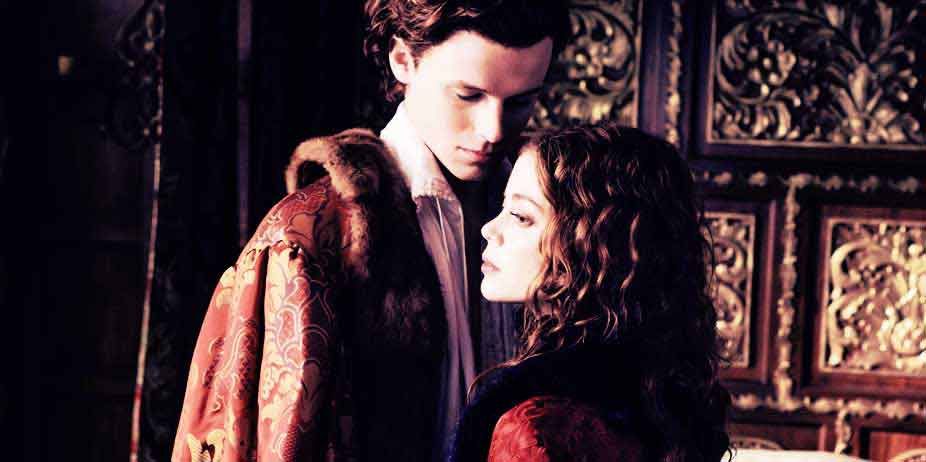
The Spanish Princess, Season Two (2020)
The second season of the series based on Philippa Gregory’s novel about Catherine of Aragon has a host of historical inaccuracies, but gorgeous costumes and memorable characters.
In only a few months, King Henry VIII (Ruairi O'Connor) and Catherine of Aragon (Charlotte Hope) have achieved a great triumph in the arrival of a perfect baby boy. To celebrate this small victory and discuss an alliance against the French, Catherine’s father, King Ferdinand of Aragon, pays them a visit and convinces them to join him in a holy war against King Louis, in retaliation for France’s invasion of one of the papal states. Eager for glory, they dispatch an English army across the Channel immediately, but within months, Orviedo (Aaron Cobham) writes to his wife Lena (Stephanie Levi-John) that the men grow restless, awaiting the arrival of Ferdinand’s army. It seems never to arrive.
Left penniless after her husband’s death, the previous queen’s cousin, Margaret Pole (Laura Carmichael), has now become a vast heiress, but cares less for that than her inability to connect to her younger son, Reginald. Surrendered to a silent order for several years, he has never forgiven her and seems unduly obsessed with his prayer books. Hopeful that she can coax him out of his shell, Margaret asks Thomas More (Andrew Buchan) to tutor him. And then, terrible news comes from abroad. News that humbles Catherine, shakes her husband’s faith in Spain, and threatens all they hold dear, on the eve of an even greater tragedy…
Catherine of Aragon is one of history’s most powerful women, a feminist who refused to back down from a corrupt and lustful king who wanted to throw her over so he could marry a younger woman. She outsmarted him at every turn until the shift of the English Church (a thin cover for “I can divorce her if I want”) forced her into exile. The real Catherine was beloved by the court and widely supported by the populace. Pick up any history book, read about her pious and regal efforts on the behalf of England, and it’s not hard to understand how no one wanted to support Henry in his quest for an annulment. She deserves an epic multi-season exploration of her life. Alas, this is not it. I’d be hard pressed to understand why this Catherine would garner an ounce of support anywhere, the way she treats everyone around her. She demeans and belittles her servants, is callous and shrill with her husband, lied about her consummated marriage, manages to kill both her sons through neglect and foolishness (leaves one of them on a cold floor for hours while she prays, and rides into battle while pregnant), and snatches away her husband’s mistress’ child just after birth to “present him” to the king.
Though the first season was adapted from a Philippa Gregory novel, the second season is entirely the brain child of television writers… and the inherent sexism bleeds through on a profound level. They have defended this as a “feminist” retelling of history, but in their narrow minds, the only way a woman can be a feminist is to be so mean and loud, no one likes them. Margaret Tudor falls prey to a similar problem—she has her moments of likability, but spends way more screen time screaming and threatening people, throwing things at her husband, turning her back on her family, and even stealing her inheritance. As is normal for these writers, the women all try to support each other but when push comes to shove, stab each other in the back while guarding their own self-interests. Anne Boleyn appears in a dozen minor scenes and never says a word, but we still get to see her stark naked as she “teases” King Henry. Perhaps that will tell you the caliber of the writing.
Plot twists come out of nowhere and character development is almost nonexistent; though we spend time with Princess Mary, she has no real personality. None of them have a spark to recommend them, except for Margaret Beaufort. And as pathetic as it was, I almost rooted for her romance with the married Sir Thomas More, because if you are going to butcher history, you may as well do it in style. Plus, the actress sold it for me, with her soulful eyes and lingering looks. It is wildly historically inaccurate from start to finish, with some truly absurd moments (a heavily pregnant Catherine being pulled off her horse in the middle of a battlefield), but does have beautiful costume design and looks sumptuous. Part of the problem is the final season has to focus so much on truly depressing things, including Catherine’s numerous miscarriages, the falling apart of her marriage (though it was never great to begin with), and her husband’s increasing womanizing behaviors. But when your writer has no sympathy for her heroine, the audience has none, either.
Sexual Content:
Language:
Surry's favorite word is the f-word, so he uses it about 16 times; other abuses of deity and general profanities.
Violence:
A man loses an eye in a joust; we see it dangling on a thread from his socket, before he pulls it out and throws it on the ground. Battle scenes in which men are ripped apart, sliced in half, and shot with arrows. A woman fires a cannon at her husband and his friends, blowing the countryside to smithereens. Henry drags Catherine down to the creek, and appears to intend to drown her; he manhandles her in other scenes. A graphic execution has a man's head sliced off with a sword while still standing -- his head bounces on the ground.
Other:
Period blood shown on a rag that a woman
throws into the fire. Numerous historical inaccuracies. A
married man has feelings for another woman.
